![]()
![]()
![]()
Use LEFT and RIGHT arrow keys to navigate between flashcards;
Use UP and DOWN arrow keys to flip the card;
H to show hint;
A reads text to speech;
46 Cards in this Set
- Front
- Back
|
Structure units |
smallest functional equivalent building units of the capsid (also known as protomer) |
|
|
Capsomers |
morphological units seen on surface of particles and represent clusters of structure units (union de varios protomers) |
|
|
Capsid |
denotes the protein shell that encloses the nucleic acid. It is build of structural units (union de varios capsomeros) |
|
|
Nucleocapsid |
capsid together with enclosed nucleic acids |
|
|
Envelope |
nucleocapsid may be invested in an envelope which may contain material of host cell as well as viral origin (se les conoce como virus encapsulado) |
|
|
Virion |
complete infective virus particle |
|
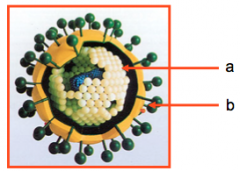
|
Enveloped virion= nucleocapsid (a) + glycoprotein membrane (b)
Example: HIV, Herpesvirus, Influenza, Hepatitis B
|
|
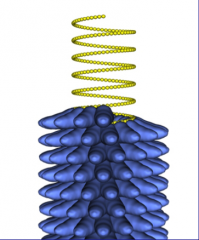
Helical symmetry |
|
|
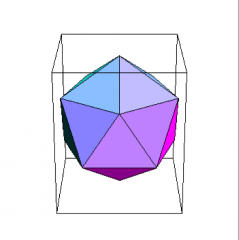
Icosahedral Symmetry
|
|
|
|
Vertex
Axis of symmetry? |
Where the vertices of 5 triangles meet (12)
axis of symmetry: 5-fold |
|
|
Triangular face
Axis of symmetry? |
Each an equilateral triangle (20)
Axis of symmetry: 3-fold |
|
|
Edge
Axis of symmetry? |
Where the sides of two triangles meet (30)
Axis of symmetry: 2-fold |
|

Complex Structure
|
|
|
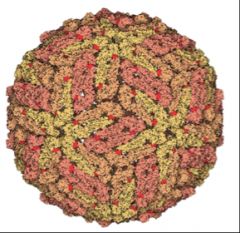
Naked icosahedral |
polio virus, adenovirus, hepatitis A virus "Naked Icons, Police Are Hectic" |
|
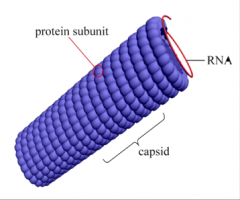
Naked helical
|
tobacco mosaic virus (TMV), no human viruses found |
|

Enveloped icosahedral |
herpes virus, yellow fever virus, rubella virus
"En-vi her yellow rub" |
|
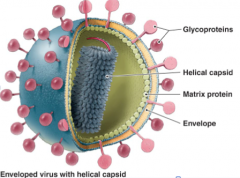
Enveloped Helical
|
rabies virus, influenza virus, parainfluenza virus, measles virus, mumps virus |
|
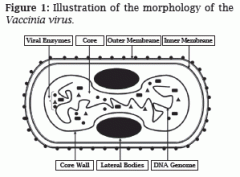
Complex Virus |
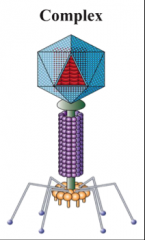
poxvirus, T4 |
|

DNA viruses |
|
|
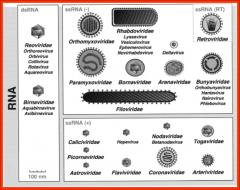
RNA viruses |
1. dsRNA: Reoviridae (Orthoreovirus, Orbivirus, Collivirus, Rotavirus, Aquareovirus) and Birnaviridae (Aquabirnavirus and Avibimavirus) 2. ssRNA (-): Orthomyxoviridae, Rhabdoviridae (Lyssavirus, Vesiculovirus, Ephemerovirus, Novirhabdovirus), Deltavirus, Paramyxoviridae, Bornaviridae, Arenaviridae,Filoviridae, and Bunyaviridae (Orthobunyavirus, Hantavirus, Nairovirus, Phlebovirus). 3. ssRNA (+): Caliciviridae, Hepevirus, Picornaviridae, Astroviridae, Flaviviridae, Nodaviridae (Betanodavirus), Coronaviridae, Togaviridae, Arteriviridae. 4. ssRNA (talk RT): Retroviridae |
|
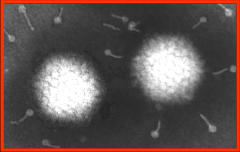
What virus is this? Description. |
Adenovirus Naked, icosahedral, ds linear DNA |
|
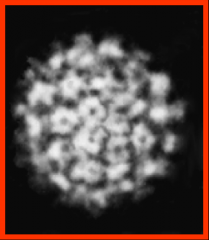
Identify the virus and describe it. |
Papillomavirus
Naked icosahedral, ds circular DNA |
|

What virus is this? Description |
Herpesviruses Enveloped, icosahedral, ds linear DNA |
|
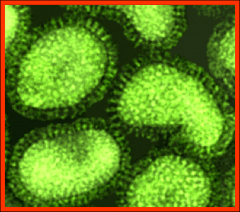
identify the virus and describe it |
Influenza virus
Enveloped, helical, negative stranded, segmented RNA |
|
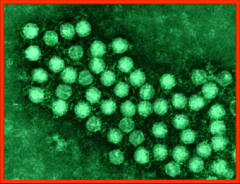
Identify and describe the virus |
Enteroviruses
Naked, icosahedral, positive stranded RNA |
|
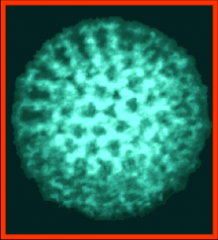
Identify and describe this virus |
Rotavirus Naked, icosahedral, double layered capsid, double stranded segmented RNAthe |
|
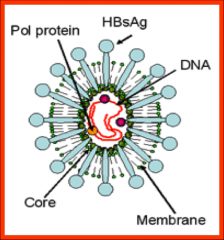
This is the general organization of: |
Hepatitis B virion (Hepadnaviridae):
|
|
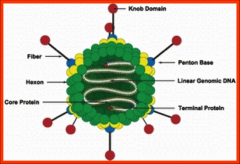
This is the organization of: |
Adenovirus (Adenoviridae)
|
|

This is the organization of: |
Retroviridae (HIV-1 virion)
|
|
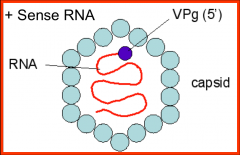
This is the organization of: |
Hepatitis A virus (Picornaviridae)
|
|
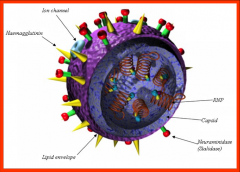
This is the organization of: |
Influenza virus (Orthomyxoviridae)
|
|

This is the organization of: |
Unconventional/Atypical virus-like agents (Viroids) ej. potato spindle tuber viroid
|
|
|
Prions |
|
|
|
Prion Hypothesis |
suggests that abnormal conformer (PrPsc) of the cellular prion protein (PrPc) can induce PrPc to undergo change of conformation into PrPsc (acumulates inside cell and affects cell function).
|
|
|
Prion disease in humans: Kuru |
|
|
|
Prion disease in humans: Creutzfelt-Jakob |
|
|
|
Prion disease in humans: Variant C-J |
Source: ingestion of infected bovine neural tissue or bone marrow age of onset: variable after ingestion mean time of death: 14 months
|
|
|
Prion disease in humans: Gerstmann- Straussler-Scheinker syndrome |
Source: Familial or sporadic Age of onset: 4th-5th decade of life mean time of death: 5yrs
|
|
|
Prion disease in humans: Fatal familial insomnia |
source: familial Age of onset: 35-61yrs Mean time of death: 13-25 months |
|
|
Defective viruses |
|
|
|
Pseudovirus |
|
|
|
DNA Viral Genomes |
|
|
|
RNA viral genomes |
|
|
|
Lipid Envelopes |
Acquisition of envelope occurs where virus-specific proteins have been inserted into host cell membranes:
|
|
|
Routes of Viral entry into body |
|
|
|
Determinants of severity of viral disease |
3. Immunopathology: hypersensitivity and inflammatory rxns 4. virus inoculum size 5. general health status of person: nutrition and other diseases influencing immune status 6. genetic make-up 7. age: ability for body to repair damage |

